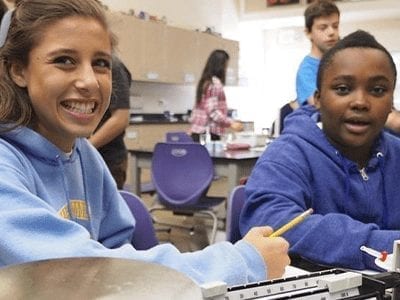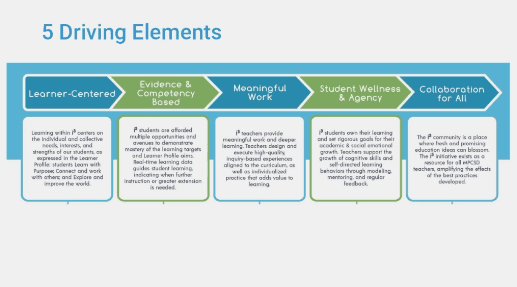Using Educational Innovation to Catalyze Change
The Big Picture
The industrial education model was massively successful, with high school graduation rates and student achievement increasing decade after decade. However, by the end of the 20th century, it was evident that the industrial education model had hit its limit with graduation rates plateauing at 80% and student achievement and engagement plummeted the longer students were in school. According to Dr. Devin Vodicka, Chief Impact Officer at AltSchool, in a recent edWebinar, reform after reform and many well-intended efforts have tried to reach the aspiration of all students being successful. Vodicka along with Erik Burmeister, Superintendent, and Theresa Fox, Coordinator of Technology and Innovation, both from Menlo Park City School District, CA, agreed that if 80% of students are graduating, then 20% of students are not graduating and that educational professionals can’t be satisfied with these statistics.
Zone of Innovation
Menlo Park City School District took a deep dive into the challenge of higher graduation rates and student engagement. Their approach to this challenge began with the development of an all-encompassing method called the Zone of Innovation, This Zone of Innovation focused on the knowledge, skills, and dispositions that are critical for learners to develop, thrive and transform in the 21st century. The five innovative components driving MPCSD’s mission for every child to achieve academic excellence include learner-centered instruction, evidence and competency-based mastery, meaningful work, students’ wellness and agency, and collaboration for all.
The learner-centered component is about gaining a better understanding of students’ strengths, interests, and needs so that teachers use differentiation to adjust for learner variability. Through learning self-awareness and self-direction, students are more engaged and take ownership of their learning beyond the classroom environment. The evidence and competency-based mastery component focuses on creating learning targets so that instruction is aligned with students’ learning, and pacing and depth determined by individual progress. Using frequent formative assessments and actionable feedback on the mastery continuum provides students with the space to iterate towards mastery. Inquiry into challenging real-world issues driven by students’ questions is the basis for meaningful work component. Students share products with an authentic audience and homework, when given, is tied to individual learning goals. The student wellness and agency component underpin all of the other components as it is about implementing student-driven goal setting, student-led conferences, and student progress tracking that offers students opportunities to collaborate with their peers, teachers, and parents. This component also involves social-emotional learning which ensures greater focus and daily connections to the learner profile by introducing, practicing, and reinforcing specific mindset and skills. Through the collaboration for all components, a safe community is created where teachers know that they are all learners and have permission to fail. This component also ensures teacher collaboration across grades and schools and scalable best practices throughout the entire district.
The Path Forward
Fox expressed that innovation is exhausting, but in their district it has transformed instruction and learning. They now have engaged and reflective teachers, learner-centered environments, and teaching practices where students exhibit greater ownership of learning. Burmeister cautions, “Innovation is a four-letter word as it takes people out of their comfort zone. It’s not saying that what we have done in the past is bad. It has been super effective and efficient, but what we also recognize that 20% of our students are still not achieving or graduating from high school.” In Menlo Park City School District’s path forward, using Rogers’ Adoption Curve, they plan to expand from innovators to early adopters in the school year 2019 – 2020. By jumping the chasm of the learning curve, they envision a school culture where the zones of innovation are no longer necessary and fall away. Future action plans include early cohort mentoring future cohorts, more personalized pathways for educators to drive their growth, moving away from catalytic work, and empowering campus buildings to lead work through a shared vision. Only then, said Vodicka, can school districts move from an industrial education model of mass production, medium quality, and low flexibility to a post-industrial education model of mass personalization, high-quality, and high flexibility.
This edWebinar was sponsored by AltSchool.
This article was modified and published by eSchool News.
About the Presenters
Erik Burmeister, Superintendent of the Menlo Park City School District in California, is passionate about innovating public education and ensuring our public schools offer students, parents, and educators a wide variety of high quality experiences that meet the demands of our rapidly changing environment. Erik served as the principal of two model schools—Union in San Jose and Hillview in Menlo Park—both award-winning institutions of rigor and innovation. In partnership with the Stanford Design School, Erik has become a leader in applying design to solve a variety of education challenges including closing the achievement gap, school redesign, technology implementation, and whole child support. Erik was named Middle Grades Principal of the Year for the Association of California School Administrators and one of the three finalists for the 2014 NASSP National Principal of the Year. In 2012, the Wiseman Group named Erik Multiplier of the Year in Education.
Theresa Fox is the coordinator for technology and innovation for Menlo Park City School District in California. She brings multiple perspectives to this work, informed by her 20 years of experience as a 2nd-8th grade teacher, a K-8 instructional coach, and an elementary assistant principal. She is passionate about engaging all students in deeper learning through inquiry (especially project-based learning and design thinking), integrating technology meaningfully, and supporting teachers’ professional growth. She is currently facilitating the work of the i3 Zones of Innovation team, a group of 20 teachers who are collaborating to “imagine, inspire, and innovate” to better meet the needs of all learners in their classrooms.
Dr. Devin Vodicka, Chief Impact Officer at AltSchool and former superintendent, is recognized as one of the most innovative educational leaders in the country. He is a three-time California superintendent of the year (2016 AASA, 2015 ACSA, 2015 Pepperdine), Innovative Superintendent of the Year, and nine-time White House honoree, both in recognition for district-wide achievement, and to advise and partner with the U.S. Department of Education.
Devin is renowned for his unique understanding of how technology can help transform learning. As superintendent of Vista Unified School District, Devin led his 25,000-student community through district-wide changes that resulted in major improvements across every academic and behavioral metric. Now Devin is working to bring similar sweeping improvements to children nationwide through his work to help develop an education technology platform to accelerate learner-centric education.
Join the Community
Leadership and Innovation is a free professional learning community on edWeb.net that serves as an online forum for collaboration on leadership and innovation in schools to meet the needs of the next generation.
AltSchool partners with schools and districts to catalyze and accelerate their shift to learner-centric education. The AltSchool Platform empowers educators to focus on each learner’s needs throughout the learning cycle and provides students with the ability to build agency and drive their learning. Whether a teacher is planning, engaging, assessing or understanding a student’s progress, they have a complete set of tools.





Comments are closed.